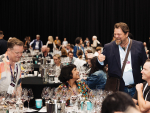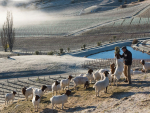Next Generation Viticulture: Capture more light to harvest more grapes
Transforming canopy management systems to maximise sunlight could increase vineyard profitability without compromising wine quality, says researchers.
The term terroir is widely used in the commercial wine world. It has traditionally been used to reflect a fusion of climate and land classification coupled to the opinions of ‘expert’ marketers and wine writers.
In Marlborough, data collected over six seasons has been used to move to a robust, quantitative way of understanding subregional differences in grape development, with the aim of providing a quantitative understanding of the Marlborough terroir.
Early research on subregional variances in Sauvignon Blanc fruit and wine composition clearly demonstrated differences in wines, particularly when the Awatere Valley is compared to the Wairau (Jouanneau et al., 2012; Trought et al., 2010). However, the number of sites used in these studies was limited. Recently, to achieve a more robust, quantitative understanding of terroir zoning in Marlborough, Dr Rob Bramley and I obtained data for Sauvignon Blanc from more than 1,000 Marlborough vineyards on a confidential basis from grape growers and wine companies over six vintages (2014-19). This enabled regional-scale maps of yield and harvest date to be drawn. By gathering the data from a number of individual vineyards, the maps identify consistent subregional differences in vineyard performance–both within and between the Wairau and Awatere Valleys. These differences raise questions on the climate, soil and management factors that may be driving subregional variation in vineyard performance.
Quantitative methods of spatial analysis provide a robust basis for characterising biophysical variation and may usefully underpin sensory and chemical analysis of wines and an improved understanding of terroir and regional/subregional distinctiveness. Such methods are free of any bias introduced to studies of terroir zoning arising from opinions based on historical or geopolitical boundaries.
The results of our research were presented at July’s Australian Wine Industry Technical Conference in Adelaide, and at the International Terroir Congress in Bordeaux, France. The research poster (If New Zealand Can Do It, Why Can’t Australia?) was awarded ‘Best poster; people’s choice’ at the Adelaide conference.

The end of the year is fast approaching, so here are some thoughts on a few of the significant developments…

OPINION: When I moved to Marlborough two decades ago, I found countless lines of tidy vines, neatly mowed and carefully…
The large 2025 harvest will exacerbate the wine industry's "lingering" supply from recent vintages, New Zealand Winegrowers Chief Executive Philip…
If you find a new consumer in a developed wine market, you are taking them from someone else, says Blank…
A New Zealand startup is providing growers with vital information for daily operations and long-term vineyard management, using a unique…